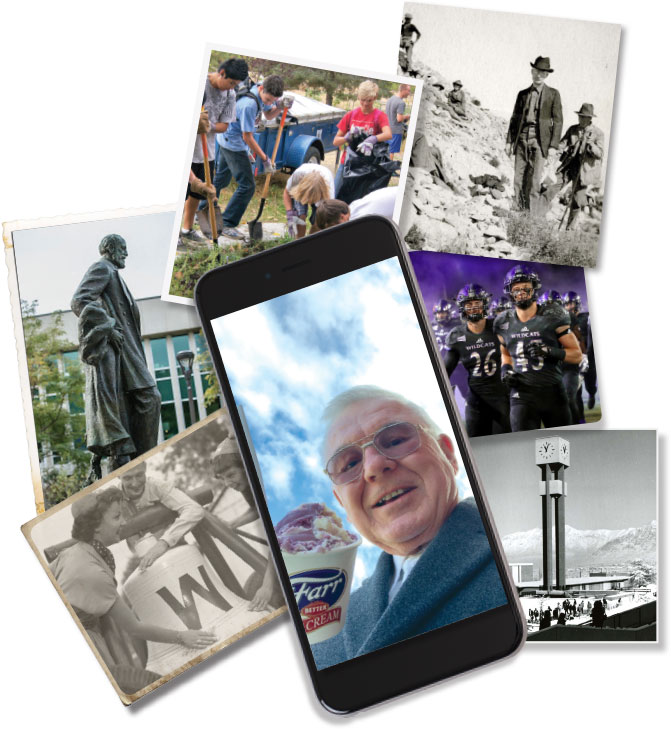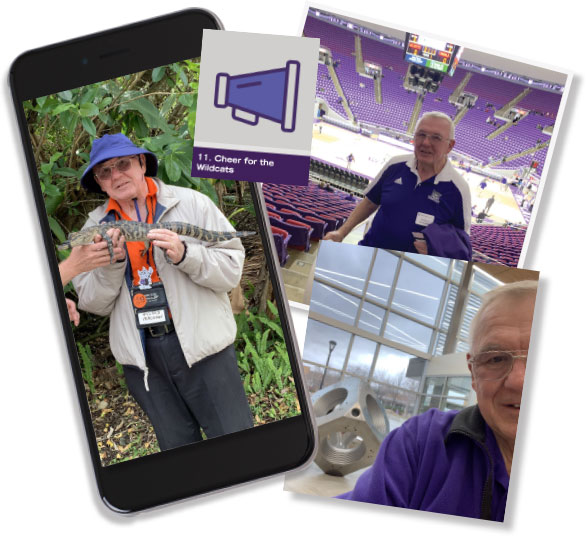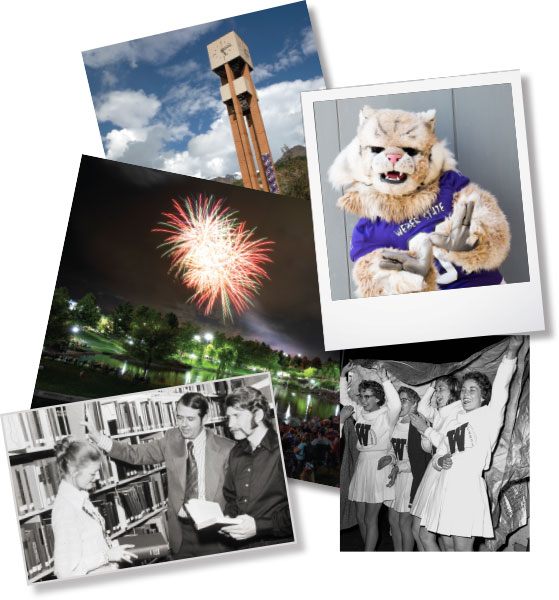The Truth About Campus Traditions
 Karin Hurst Marketing & Communications
Karin Hurst Marketing & Communications
Packing his suitcase for a trip to Cuba, Willard Z. Maughan insisted on including a 4-inch-tall, cardstock cutout of Waldo the Wildcat. Not only did the Ogden native wedge the affable feline between layers of breathable-cotton clothing and miniature tubes of lip balm, Caladryl lotion and sunscreen — he is a retired dermatologist after all — he also made sure that his die-cut traveling companion didn’t miss a single vacation photo-op.
A quick swipe through the images Maughan captured on his trusty mobile phone reveals: Waldo, propped up by a can of Ciego Montera tuKola (Cuban Coca-Cola); Waldo precariously perched atop what appears to be a slightly perturbed baby alligator at Everglades National Park; and Waldo, lounging in the cabin of a Royal Caribbean cruise ship next to a white elephant. (Well, technically, it’s a white bath towel folded into the shape of an elephant.) And that’s just a random sampling of Waldo portraits.
You might think the 75-year-old former WSU Alumni Board president has taken his passion for Weber State’s lovable mascot one step beyond sanity. But, as Maughan nestles into a comfy, cloth patio chair and begins talking over the burble of spring snowmelt rushing into the creek bed that intersects his verdant backyard, his story starts to make sense.
Fun or Function?
Nearly every university has time-honored traditions. From annual celebrations to goofy competitions to fight songs, campus traditions encourage students to let loose, have fun and display school pride. But some scholars and researchers believe there’s more to college traditions than what meets the eye. Simon J. Bronner, distinguished professor emeritus of American studies and folklore at Pennsylvania State University, views campus traditions as important coming-of-age rituals.
 According to Bronner, there are very few ways of acknowledging adulthood in America. While other nations have recognized rites of passage that mark a young person’s transition into adulthood, American society is vaguer about that. Folklorists, like Bronner, say students who attend college immediately after high school are at a “liminal stage of being betwixt and between” childhood and adulthood. A college campus, therefore, serves as a safe, acceptable location for younger students to act out the dramas, performances and rituals of becoming grown-ups. While most of us think campus traditions are lighthearted and trivial, Bronner believes that when scrutinized at a deeper level, campus traditions expose significant symbols and metaphors about a college student’s life experience, values, aspirations and anxieties.
According to Bronner, there are very few ways of acknowledging adulthood in America. While other nations have recognized rites of passage that mark a young person’s transition into adulthood, American society is vaguer about that. Folklorists, like Bronner, say students who attend college immediately after high school are at a “liminal stage of being betwixt and between” childhood and adulthood. A college campus, therefore, serves as a safe, acceptable location for younger students to act out the dramas, performances and rituals of becoming grown-ups. While most of us think campus traditions are lighthearted and trivial, Bronner believes that when scrutinized at a deeper level, campus traditions expose significant symbols and metaphors about a college student’s life experience, values, aspirations and anxieties.
Building a Tradition of Giving
Then there’s the monetary value of school traditions. In a 2015 study, researchers set out to determine factors that impact alumni loyalty and giving at institutions of higher education. They found that alumni who perceive their alma mater has valued, well-established traditions and a vibrant alumni organization, exhibit stronger behaviors associated with loyalty than alumni who don’t feel their university has valued, well-established rituals and a high-functioning alumni organization. The study concluded that university initiatives designed to enhance and strengthen alumni relationships are crucial. The researchers recommended that alumni associations, in particular, be viewed as strategic, vital university assets that serve as “keepers and promoters” of school traditions and rituals.
One behavior generally indicative of alumni loyalty is charitable giving. Today, in higher education’s precarious economic climate, it’s imperative for public universities to foster active, dedicated alumni to garner financial support for scholarships, programs and facilities that can’t be solely sustained through state funding. Statistics show that donors tend to support things they truly care about. Maughan’s annual gifts to WSU are perfect examples. “My wife and I support Spanish and nursing scholarships at Weber State,” he explains. “Now, why would I want to do that if I didn’t care about Weber State or feel connected to the university?”
Which brings us back to the question of why Maughan lugged Waldo the Wildcat all the way to Cuba.
By standard definition, Maughan is not a Weber State alumnus. Although he took advanced placement courses at Weber as a high school senior, he spent the bulk of his educational career at other institutions. And yet, he considers himself a bona fide Wildcat and voluntarily serves on the WSU Alumni Association’s Emeriti Alumni Council. Why? “Because Ogden is home, and Weber State is in Ogden,” he says with a heap of purple pride. After WSU Alumni Relations Executive Director Nancy Collinwood BS ’94 and Rebecca Gibson AS ’09, alumni engagement coordinator, met with the emeriti council to outline a new program called Traditions Keeper, Maughan felt an urge to participate.
Tracking Wildcat Traditions
Traditions Keeper seeks to build school pride and bond students, alumni and friends through shared involvement in Wildcat traditions. The program is targeted at freshmen, who usually have four years to complete and track 50 preselected activities. However, alumni and friends, in Utah and elsewhere, are also invited to participate and earn incentive prizes along the way.
 In its role as “keeper and promoter” of Weber State traditions and rituals, Alumni Relations teamed with WSU Marketing & Communications to choose 50 well-established Wildcat traditions, research their origins and create a website, weber.edu/traditionskeeper, to house historical information and anecdotal stories. Rules specify that current WSU students must complete all 50 traditions before they earn the right to call themselves a genuine WSU Traditions Keeper. Friends and alumni, however, are only required to do 35.
In its role as “keeper and promoter” of Weber State traditions and rituals, Alumni Relations teamed with WSU Marketing & Communications to choose 50 well-established Wildcat traditions, research their origins and create a website, weber.edu/traditionskeeper, to house historical information and anecdotal stories. Rules specify that current WSU students must complete all 50 traditions before they earn the right to call themselves a genuine WSU Traditions Keeper. Friends and alumni, however, are only required to do 35.
As you already may have guessed, Maughan’s favorite activity was tradition No. 16: Travel with Waldo. But he also enjoyed No. 2: Eat Purple Pancakes. To fulfill that tradition, Maughan added blue and red food coloring to pancake batter and poured the mixture onto a hot griddle in the shape of a Wildcat. “It didn’t really look too much like a Wildcat, but it had ears,” he chuckles. Tradition No. 4: Visit Legacy Wall sparked a flame of nostalgia in Maughan. As a youngster, he lived within walking distance to Weber College’s 25th Street campus. He performed with a singing group led by Glenn Hanson, who taught music at Weber from 1945 to 1962. “We practiced in the old Moench Building,” Maughan recalls. “The thing I remember most about that place is how loudly the floors creaked.” Maughan says tradition No. 43: Explore Wildcat Store got him into the most trouble. “I can’t remember what I bought there, but it had to be something because I can’t leave a souvenir shop, hardware store or bookstore without bringing something home.” Maughan says the most enlightening tradition he completed was No. 30: Explore Something New at WSU. While touring the university’s new Dumke Center for Interprofessional Education in Healthcare, he saw a 3D virtual cadaver. The cadaver lies embedded in a 6-foot, interactive table. (Think gigantic iPad.) With the flick of a finger, a student can “slice through” skin, bone, muscles, organs and tissue to peer closely at anatomical details of the human body. “That was really cool,” says Maughan.
It took Maughan about four months to earn his WSU Traditions Keeper title. He claims his most difficult task was uploading photos to an online account. “I’m technologically challenged,” he confesses. “So, I took my phone over to the Lindquist Alumni Center and had Rebecca do that for me.”
A Loud and Proud Defense
Naturally, any self-respecting college or university would deem its own campus traditions a cut above the rest; an official ranking would be largely subjective. Nevertheless, BestColleges.com, an online company that posts various rankings to help prospective students decide which schools best meet their needs, has taken a stab at it. With a rubric based on uniqueness and longevity, the company compiled a top 25 list of Best Campus Traditions in 2019. Shockingly, no Weber State Wildcat tradition made the top 25!
Because we feel unjustly overlooked, we’ve invited three Wildcat “mystery traditions” to explain why they deserve national recognition for their great-great-greatness. (Scroll down to reveal the mysteries.)
Mystery Tradition No. 1:
Standing over 9-feet tall and weighing at least a ton, I’m the original “big man on campus.” I was created by prolific American sculptor Avard Fairbanks, the same Utah artist who, in the 1920s, designed the iconic ram head logo for Dodge. First, Fairbanks molded me from clay; then, he sent me to Italy to be cast in bronze. I moved to Weber State on Oct. 22, 1964, but was relocated to the center of a prominent crosswalk in 1972. Facing east for many years, I kept silent watch over Weber State students and faculty. Then, in 2006, university administrators thought I should be rotated to face west so I would appear to embrace the greater Ogden community. With this fresh perspective, I now symbolize the university’s famously friendly campus. I’m not sure exactly when, or how, it began, but, over time, students and other passersby started giving my toe a brisk rub for good luck, especially during finals. Hey, I figure it’s a win-win situation — they get higher test scores, and I have perpetually polished boots!
Who am I?
Mystery Tradition No. 2:
I consider myself Weber State University’s “coolest” tradition. I made my campus debut in the winter of 1995, an exciting time in Wildcat basketball history. With 10 wins and two losses, the “Lady ’Cats” — yes, that’s what our women’s basketball team was called back then — were on their way to breaking a pre-conference record. Meanwhile, the men’s team was on a red-hot, 11-home game-winning streak, and ramping up to scorch BYU-Hawaii in the Dee Events Center on Friday, Jan. 6. To celebrate what would become the team’s 200th home-court victory that evening, Farr Better Ice Cream, Utah’s oldest ice cream manufacturer, introduced — me, a yummy, vanilla- and grape-flavored frozen concoction designed especially for fans and supporters of Weber State University. Of course, I’m a little older now, but just as sweet, delicious and available at the company’s original shop, 286 E. 21st Street, Ogden. Every so often, you’ll also find me at Farr’s South Ogden location, 4013 Riverdale Road.
Who am I?
Mystery Tradition No. 3:
Those irksome quackers and honkers splashing around the Ada Lindquist Plaza retention pond would never admit this, but insiders agree — I’m WSU’s most famous campus icon. I’ve been here, marking time and performing hourly, since 1971. As far as I know, I was the first campus structure to be named in honor of someone. It’s true. There was never an official naming ceremony for the so-called “Moench Building” on our old 25th Street campus. I, on the other hand, was dedicated during a fierce, December blizzard. (I guess I’ve always had a flair for the dramatic.) Nothing at WSU escapes my attention. (With four faces, I see it all.) Generally speaking, I’m not one to “kiss and tell,” but that’s exactly what has been going on here for decades. Couples from near and far come to my plaza to steal a midnight kiss during Homecoming Week. Afterward, they proclaim themselves TRUE Wildcats. Considering my elevated stature, who could have predicted that I’d ever be linked to such a scandalous practice? (Luckily, it’s dark, so you don’t see me blush.)
Who am I?
Mystery Tradition Answers:
1. Statue of Louis F. Moench
2. Wildcat Wripple Ice Cream
3. Stewart Bell Tower
